Viljandi County
Viljandimaa | |
|---|---|
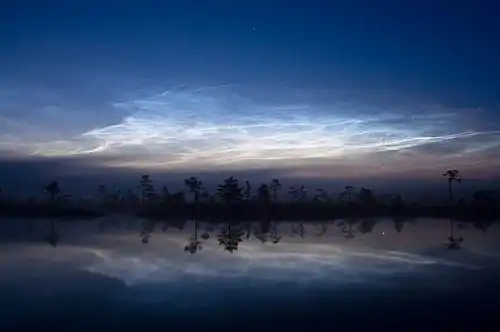 | |
 Coat of arms | |
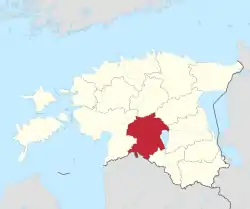 | |
| Country | Estonia |
| Capital | Viljandi |
| Area | |
| • Total | 3,422.49 km2 (1,321.43 sq mi) |
| Population (2022) | |
| • Total | 45,411 |
| • Rank | 6th |
| • Density | 13/km2 (34/sq mi) |
| Ethnicity | |
| • Estonians | 95.5% |
| • Russians | 2.4% |
| • other | 2.9% |
| GDP | |
| • Total | €896 million (2022) |
| • Per capita | €19,692 (2022) |
| ISO 3166 code | EE-84 |
| Vehicle registration | D |
| Website | www |
Viljandi County (Estonian: Viljandi maakond or Viljandimaa; German: Kreis Fellin) is one of 15 counties of Estonia. It is located in southern Estonia bordering Pärnu, Järva, Jõgeva, Tartu and Valga counties.
History
Viljandimaa, under the German name of Kreis Fellin, was an important centre of commerce and power in the Middle Ages. Today, there are numerous castle ruins there dating from that time.
Soomaa National Park is a national park located partially within Viljandi County, Estonia. Soomaa ("land of bogs") protects 390 km2, and is a Ramsar site of protected wetlands. The park was created in 1993.[2]
County government
The Viljandi County government (Estonian: Maavalitsus) had been led by the Governor (Estonian: maavanem), who used to be appointed by the Government of Estonia for a term of five years. Jüri Ratas's first cabinet decided to abolish the institution, which went into effect in 2018. Lembit Kruuse was the final Governor to serve the role.
Municipalities
The county is subdivided into municipalities. There is one urban municipality (Estonian: linnad – towns) and three rural municipalities (Estonian: vallad – parishes) in Viljandi County.
| Rank | Municipality | Type | Population (2018)[3] | Area km2[3] | Density[3] |
|---|---|---|---|---|---|
| 1 | Mulgi Parish | Rural | 7,652 | 881 | 8.7 |
| 2 | Põhja-Sakala Parish | Rural | 8,203 | 1,153 | 7.1 |
| 3 | Viljandi Parish | Rural | 13,950 | 1,374 | 10.2 |
| 4 | Viljandi | Urban | 17,758 | 15 | 1,183.9 |
Religion
| Religion | 2000 | 2011 | 2021 | |||
|---|---|---|---|---|---|---|
| Number | % | Number | % | Number | % | |
| Christianity | 8,859 | 19.1 | 5,823 | 14.3 | 5,040 | 13.0 |
| —Orthodox Christians | 1,121 | 2.4 | 964 | 2.3 | 930 | 2.4 |
| —Lutherans | 7,178 | 15.5 | 4,373 | 10.7 | 3,390 | 8.8 |
| —Catholics | 104 | 0.2 | 37 | 0.09 | 60 | 0.1 |
| —Baptists | 130 | 0.2 | 95 | 0.2 | 210 | 0.5 |
| —Jehovah's Witnesses | 119 | 0.2 | 134 | 0.3 | 110 | 0.2 |
| —Pentecostals | 88 | 0.1 | 60 | 0.1 | 110 | 0.2 |
| —Old Believers | 1 | 0.002 | 5 | 0.01 | - | - |
| —Methodists | 117 | 0.2 | 2 | 0.004 | - | - |
| —Adventists | 1 | 0.002 | 69 | 0.1 | 60 | 0.1 |
| —Other Christians | - | - | 84 | 0.2 | 170 | 0.4 |
| Islam | 8 | 0.01 | 9 | 0.01 | 130 | 0.3 |
| Buddhism | - | - | 45 | 0.1 | 20 | 0.05 |
| Other religions** | 216 | 0.4 | 346 | 0.9 | 410 | 1.0 |
| No religion | 21,757 | 47.0 | 29,733 | 73.2 | 28,980 | 74.4 |
| Not stated*** | 8,105 | 17.5 | 4,623 | 11.4 | 3,930 | 10.2 |
| Total population* | 46,243 | 40,579 | 38,530 | |||
| *The censuses of Estonia count the religious affiliations of the population older than 15 years of age.[4] ".[4] | ||||||
Gallery
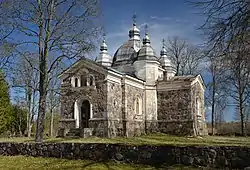 Arussaare orthodox church, built in 1873
Arussaare orthodox church, built in 1873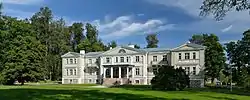 Suure-Kõpu manor main building
Suure-Kõpu manor main building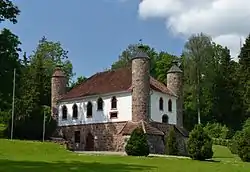 Heimtali manor distillery kitchen
Heimtali manor distillery kitchen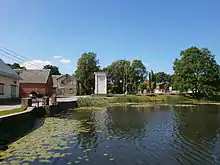 Reservoir in the town of Suure-Jaani
Reservoir in the town of Suure-Jaani Võrtsjärv lake; view from the village of Valma
Võrtsjärv lake; view from the village of Valma Ruins of Viljandi castle
Ruins of Viljandi castle Õisu manor watermill
Õisu manor watermill St. John's Church in Viljandi
St. John's Church in Viljandi
References
- ↑ "GROSS DOMESTIC PRODUCT BY COUNTY". stat.ee.
- ↑ RMK: Soomaa National Park. Retrieved 25 January 2016.
- 1 2 3 "Elanike demograafiline jaotus maakonniti". Kohaliku omavalitsuse portaal. Retrieved 2 April 2018.
- 1 2 3 Official census data from Statistics Estonia:
- 2000 Census:
- 2011 Census:
- 2021 Census:
External links
- Viljandimaa – Official website
- Viljandi County Government (in Estonian)
